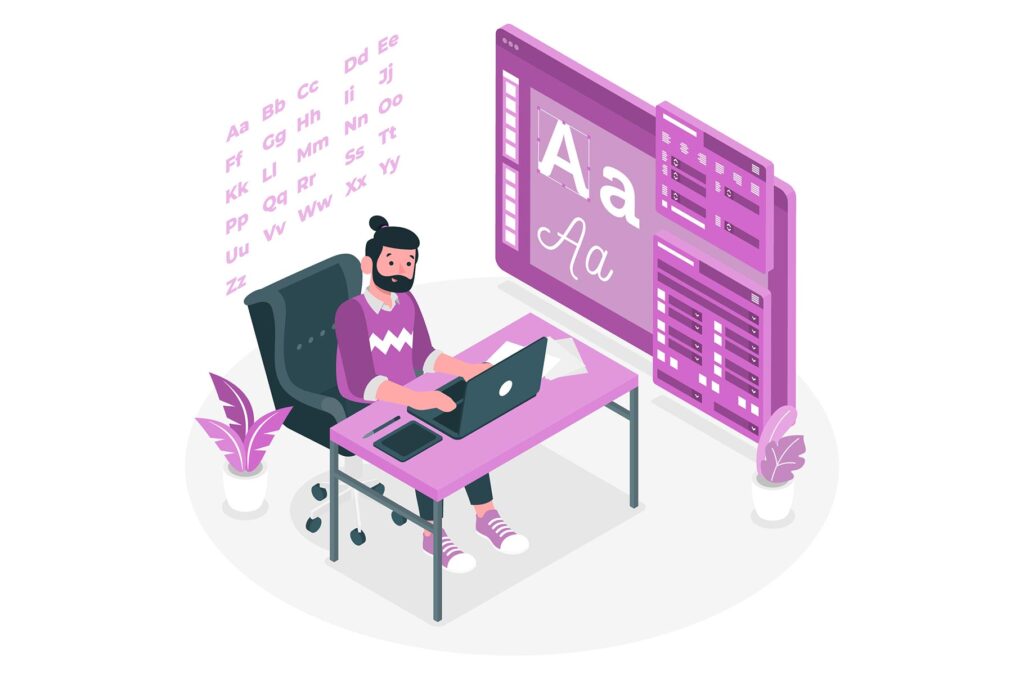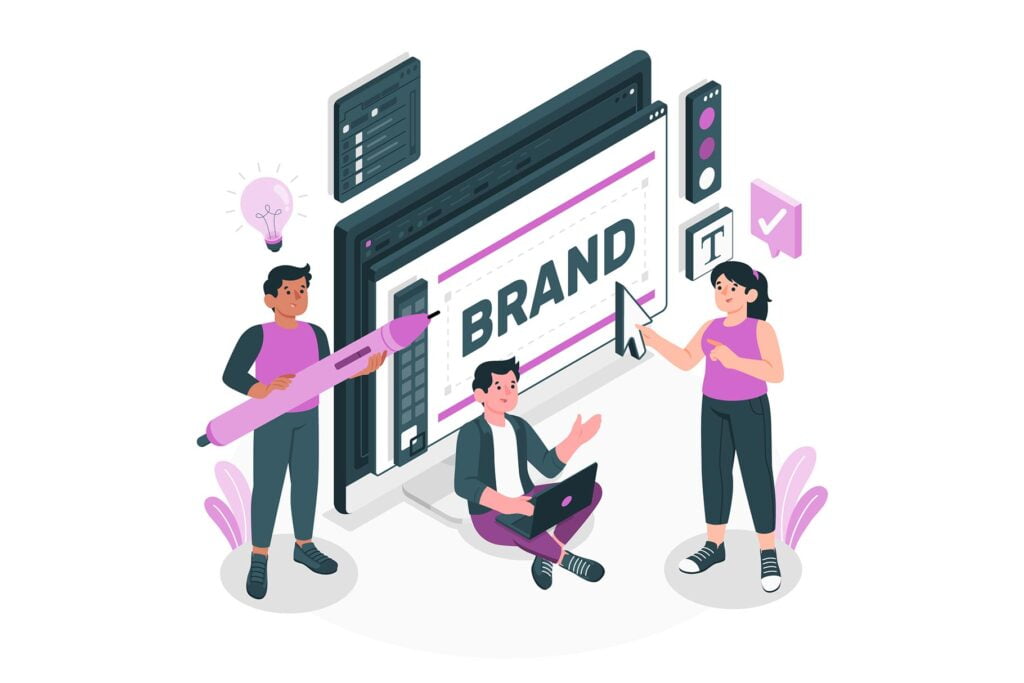Typography plays a key role in the visual appeal of the logo design. The best choice of font can make or break your design, so it is essential to choose the right typeface for your project.
The right choice of typography can help you create a memorable logo that is easy to read and looks professional. On the other hand, choosing the wrong font can result in an unprofessional design that may fail to attract your target audience.
The aim of this article is to help you understand the role of typography in logo design and how to choose the right typeface for your project.
Why typography is important in logo design?

Typography is the craft of arranging a type to create a desired appearance on a page. It is one of the most important design elements in logo design and shouldn’t be overlooked.
A logo is the first impression of your brand, and it should be visually appealing and memorable. The font you choose for your logo plays an important role in creating a memorable design that can easily be read by people from different cultures.
Typography plays a vital role in logo design, as it helps communicate the brand identity through its use of fonts, colors, and spacing.
A great example is Coca-Cola’s iconic red color scheme that has been used since 1886 when they first started using their famous script typeface which is now known as “Coca-Cola” font or “Palladio”.
How to choose the right typography for a logo design?
Choosing the right font for your logo is an important part of the design process. Some fonts are easy to read, and some are not. Some fonts are unique and memorable, while others are not.
Choosing the right typeface will help you create a strong and memorable brand identity for your business or organization that can stand out from the crowd in today’s competitive marketplace.
When it comes to choosing a font for your logo, you need one that is easy to read and looks good on a variety of media. You also want a font that reflects your brand’s personality.
There are a variety of different fonts that you can use for your logo design, including serif and sans-serif. Serif fonts have small lines at the ends of characters that add extra detail to the letters. These are often considered more formal than sans-serif fonts which don’t have these extra details.
The most commonly used serif fonts are Times New Roman and Arial. The most popular sans-serif fonts are Helvetica, Verdana, and Calibri.
While you can use any font you want for your logo, certain ones work better than others. If you are designing a logo for a company in the financial industry, it’s probably best to use a serif font like Times New Roman.
If your business is more casual or friendly, then a sans-serif font like Calibri may be better suited for your purposes.
So, let’s have a look at the factors that play an important role in choosing the perfect typography for your logo design.
Also, read 15+ Best Adventure Fonts for Stunning Designs
Successful brand identity

Typography is the most important aspect of logo design. It makes or breaks your logo design, so it is crucial that you get it right. Typography is a combination of fonts and their sizes, colors, and styles that create a specific visual identity.
In any successful brand identity, typography plays a key role. It is the first element that attracts your audience’s attention and helps them understand what the brand stands for. \\\\\
There are many factors that influence your choice of typography for a logo design. You need to consider the message you want to convey through your brand identity, as well as the target audience and their preferences.
If you are designing a logo for a kids’ clothing store, then using cute fonts may not be the best option because it could make adults view your brand negatively.
You also need to consider the current trends in logo design, as well as the typeface that will represent your business.
So, in order to create a brand that is memorable and will stand the test of time, it is important to pay attention to every detail. You should also consider the following tips when choosing a typeface:
- The language should be clear and accessible.
- It should reflect the essence of your brand.
- The font should complement your logo, not overpower it.
- The font must be easy to read and understand.
- It should reflect the personality of your brand.
- The font should complement your logo, not overpower it.
- The font should be memorable and easily recognizable by your audience.
Readability

The selection of fonts while designing a logo can be a tedious task. The first thing you should do is consider the readability of your logo. If it is difficult to read, chances are that people will not remember it.
So, you should choose a font that is easy to read and has a legible typeface. The primary goal of a logo is to establish an emotional connection with the audience. So, if the font is not readable, it will not be able to achieve this goal.
The font should be simple and legible. It should not contain any special characters that may confuse your audience.
For example, if you are designing a logo for a company that sells beauty products, choose a font that is feminine and elegant such as Candara or Gotham Rounded. A logo with an attractive typeface can create an emotional connection between the audience and the brand.
The readability of any logo is very important, as it will help you convey your message clearly. For example, if the audience can’t read the company name in your logo, they may not recognize it as a brand.
Choice of the correct font

When it comes to logo design, fonts are the most important part of your logo. They determine how your brand will be perceived, so you need to choose them carefully.
The font should be easy to read, and it should match the brand’s personality. The most common fonts for logos are sans-serif and serif. Sans-serif fonts are easy to read at small sizes and look good in just about any color combination.
They are also generally more modern and clean-looking than serif fonts, which are better for logos that have a vintage feel.
You may also want to choose a font that is easy to read in small sizes, as many people will only see your logo on their computer screen.
A common mistake is to choose a font that is too similar to the one in your brand’s name. This makes it hard for people to tell the difference between your logo and your brand name.
You should also consider whether your font is legible. This is especially important if your logo will be printed in black and white, or if it will be displayed at a small size on the screen. Some fonts can be hard to read when they are small or printed in black and white.
Voice of the logo

The voice of a logo is its personality, brand voice, and tone. It’s how you want your brand to come across to consumers.
The message of your logo should be clear through typography alone–you don’t need any other elements like images or color to explain what it means.
Typography plays an important role in defining this aspect of a logo design because it can influence how people perceive your company’s personality or character traits. For example:
- A playful typeface can make customers feel relaxed and approachable;
- A serif font could give off an authoritative vibe;
- An elegant script might create feelings of luxury or exclusivity.
The typeface you choose should be able to communicate your brand’s personality on its own. A logo that uses an all-caps, sans-serif font may feel more serious and professional than one with a script serif.
Brand vision

The brand vision is the way a brand communicates its values and purpose. It’s what makes your company unique, and it should be clearly communicated to the audience.
Your logo and its typography should reflect this vision in order to help potential customers understand what you stand for as a business or organization, as well as how they can benefit from doing business with you.
When choosing a font for your logo, you should consider the message it will convey. For example, if your business is all about fun and whimsy, then you may want to use more playful fonts like script serifs or display fonts.
On the other hand, if you’re selling luxury goods or services, then a more elegant font could be appropriate.
Your logo is the first thing that people see when they encounter your brand, so it’s important to make a good first impression. You want something that conveys professionalism and respectability without being too stuffy or boring.
You may also like 12+ Best Fonts For Stunning Logo Design
Aesthetic appeal

Aesthetic appeal is how a logo looks. It can be influenced by the font style, color, shape, and size of a logo. Aesthetic appeal is important because it’s what will be used in marketing materials and advertisements for your business or organization.
When it comes to logo design, there are many different factors that contribute to its success. Aesthetics is one of the most important considerations because it’s what will be used in marketing materials and advertisements for your business or organization.
Aesthetics may not seem like an important factor when choosing a font for logo design but they play an essential role in creating an effective brand identity that resonates with customers.
For example: if your company sells beauty products then you probably wouldn’t want to use an overly masculine sans serif font like Helvetica Neue Bold Extended because it doesn’t fit with its target audience – women who care about their appearance!
In addition to aesthetics, you’ll also want to consider the practicality of your font selection.
For example: if you’re creating a logo for an organization that’s well known for its charitable work then it would be counterproductive to use a font that’s difficult to read like Comic Sans because it makes people think about clowns and not the good deeds being done by your company!
Communication

Typography is also an important aspect of communication. The logo should be able to communicate with the target audience and brand owner in a way that makes sense to both parties.
As a result, typography plays an important role in this process by conveying meaning through words and symbols.
In addition to being able to communicate with your audience, using typography as part of your logo design can help you achieve other benefits such as:
- Finding the right font for your business name or slogan
- Creating consistency across all marketing materials (print materials such as flyers or brochures)
- Creating a professional image that your target audience will be able to identify with.
- Creating a unique visual identity that sets your brand apart from others.
Choosing the right font for your logo or slogan will help you achieve the above benefits. There are many types of fonts available and most of them can be used in your logo design.
However, choosing a font that is not appropriate for your brand or industry could have a negative impact on how people perceive you.
Immediate Attention

The typography that you choose for your logo will have an impact on how people respond to it. A bold, bright font will draw immediate attention, while a more subtle choice may not be as effective.
The type of font you choose should reflect your brand identity and what you want people to take away from your logo.
The right font can help you to achieve the desired effect. A good example is the Coca-Cola logo, which has been designed with a cursive font that looks friendly and approachable. This is an example of how choosing the right font can help to create an impactful design.
The type of font you choose will depend on the type of business that you are running and what kind of message you want to convey.
If your company is selling luxury goods, then a bold, elegant font would be an ideal choice. However, if you’re selling something more casual, such as jeans or T-shirts, then a simple serif font might be better suited for your brand.
So, for grabbing the attention of your customers, choose a font that will convey the right message and make the design look professional.
Brand hierarchy

Brand hierarchy is the order and organization of elements within a logo design. Establishing a visual hierarchy helps users understand what’s most important about your brand—what sets you apart from other brands in the same industry.
The fonts of your logo or slogan are important to consider when creating a visual hierarchy. You should always use a sans-serif font for your brand name, slogan, and tagline because they’re easier to read than serif fonts.
Additionally, a sans-serif font is often used for subheaders and body copy. A serif font can be used for smaller elements like icons or logos.
You should also consider using different colors to create a visual hierarchy within your logo design. You can use color to draw attention to certain areas of the logo, such as using red for a brand name over black.
You should also be aware of how a color scheme can affect the overall look and feel of your logo design. For example, using predominantly warm colors like reds, oranges, and yellows will create a more energetic feeling while cool colors like blues and greens are more calming.
Conclusion
Typography is an important element in logo design and can make or break your brand. It’s important to keep in mind that typography is not just a font, it’s how you use that font in order to communicate with your audience. Typography can help express the voice of your brand and create an aesthetic appeal so people want to buy from you rather than someone else who doesn’t use good typography skillsets when making logos.
Recommended reading: 20+ Best Decorative Fonts for Spectacular Designs (2023)
FAQs
What is typography in logo design?
Typography is the way a logo’s text looks and feels. It’s a combination of elements like font, font size, alignment, spacing, and color that contribute to the overall design of the logo.
How does typography affect a logo?
Typography is the art and technique of arranging type, type design, and modifying type glyphs. It often refers to the style and appearance of a font, which is the collection of letters, numbers, and symbols.
Typography can also be used to affect logos by emphasizing certain aspects of a logo design that could be overlooked without proper font selection. For example, a logo with a lot of text may benefit from using a sans-serif font for its body copy to make it easier to read.
What is the role of typography in branding?
The role of typography in branding is to convey the brand’s values, mission, and personality through the use of typefaces. It is also used for making a statement about the company or product.
How do you use typography as a logo?
Typography is the use of typefaces and letterforms in a design. Typography can be used to identify a brand, create visual hierarchy, and establish tone.
A logo is the visual representation of a brand. A logo should be instantly recognizable and should convey what your brand stands for.
3 thoughts on “Role of Typography in Logo Design (The Ultimate Guide)”